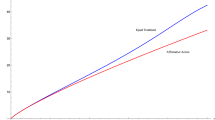Abstract
Equilibrium in a game of agents is studied with a competitive stimulation mechanism, in which only the agent with the best results of activities is awarded commission.
Similar content being viewed by others
REFERENCES
Gubko, M.V. and Novikov, D.A., Teoriya ugr v upravlenii organizatsionnymi sistemami (Game Theory in Control of Organizational Systems), Moscow: Sinteg, 2002.
Iskakov, M.B., Equilibrium in Safe Strategies, Avtom. Telemekh., 2005, no. 3, pp. 139–153.
Novikov, D.A., Mechanisms for Stimulation in Dynamic and Multielement Socio-Economic Systems, Avtom. Telemekh., 1997, no. 6, pp. 3–26.
Novikov, D.A. and Tsvetkov, A.V., Mekhanizmy stimulirovaniya v mnogoelementnykh organizatsionnykh sistemakh (Mechanisms for Stimulation in Multielement Organizational Systems), Moscow: Apostropf, 2000.
Mas-Collel, A., Whinston, M.D., and Green, J.R., Microeconomic Theory, New York: Oxford Univ. Press, 1995.
Myerson, R.B., Game Theory: Analysis of Conflict, London: Harvard Univ. Press, 1991.
Author information
Authors and Affiliations
Additional information
__________
Translated from Avtomatika i Telemekhanika, No. 10, 2005, pp. 156–160.
Original Russian Text Copyright © 2005 by Ivashchenko.
Rights and permissions
About this article
Cite this article
Ivashchenko, A.A. A Competitive Stimulation Mechanism. Autom Remote Control 66, 1673–1676 (2005). https://doi.org/10.1007/s10513-005-0200-4
Received:
Issue Date:
DOI: https://doi.org/10.1007/s10513-005-0200-4




